The Joseon Royal Palaces in Seoul, South Korea are simply a sight to behold, with their colourful painted roofs and bright, flowery interiors. Even though their palaces were built using Chinese traditions, they still retained the original elements of Korean architecture. Thus, these royal palaces certainly look different from those in other Asian countries.
Meanwhile, the fortresses in Korea hold symbolic meaning in Korean culture. Their main purpose was to fortify and protect the country against impending enemy attacks, especially during war. Some fortresses even have emergency palaces within them.
Here, we’ve listed the must-see fortresses and palaces in South Korea. Not only are these aesthetically pleasing to look at, but they also provide an exquisite backdrop for memorable pictures to take (preferably while in a hanbok) during your trip!
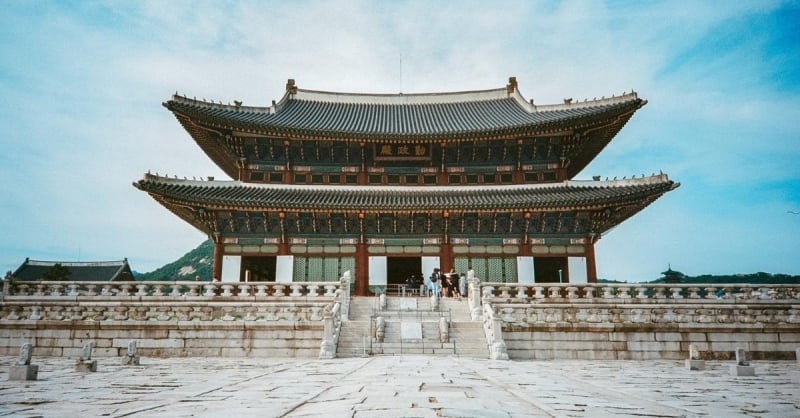
Image credit: Daniel Bernard
Want to be taken on a cultural tour of all these historical sites (and more)? With Nam Ho Travel, winner of the Best for Korea category at the 2022 TripZilla Excellence Awards, you can simply show up with your luggage at the airport and they’ll take care of your trip. The perfect tour package would be their 8D 6/7N INSPIRING KOREA tour, where you’ll get taken to Incheon, Jeju, Busan, and more!
The five Joseon palaces in South Korea
Rich in culture and heritage, these opulent palaces were once the homes of royalty in the Joseon dynasty (1392–1910). Visiting them will surely bring you back to the past whereby you can witness how the kings and queens used to live. Besides looking at it from a historical viewpoint, you can see how these palaces in South Korea have changed over time to integrate into modern society.
We recommend purchasing the Royal Palace Pass (₩10,000) that grants you access to four palaces and a Royal Shrine: Gyeongbokgung Palace, Changdeokgung Palace, Changgyenggung Palace, Deoksugung Palace, and Jongmyo Royal Shrine. Access to Gyeonghuigung Palace is not included, as it is free to visit.
Tip: Those wearing a hanbok upon entering may be granted free admission. Alternatively, you can visit on the last Wednesday of the month (aka Culture Day) to enter for free.
1. Gyeongbokgung Palace (Palace Greatly Blessed by Heaven)
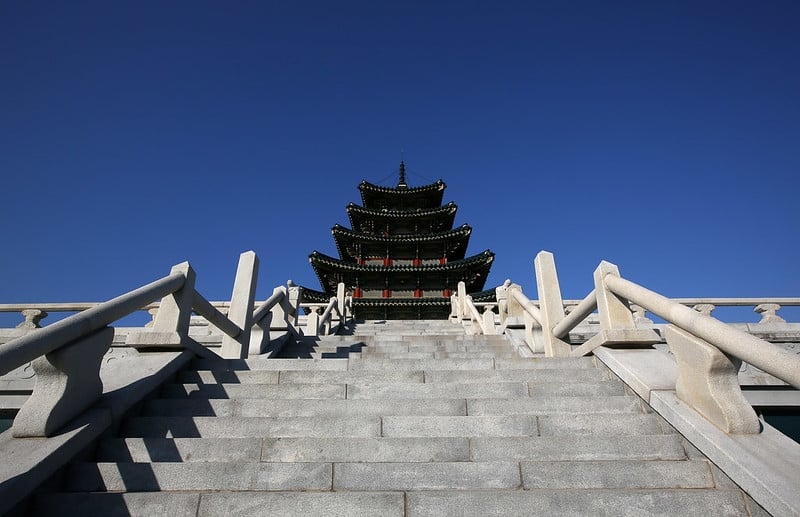
Image credit: Republic of Korea
One of Korea’s quintessential palaces is Gyeongbokgung Palace (aka Northern Palace), which remains a famous tourist destination. It is often compared to the Forbidden City in Beijing. The complex consists of a throne hall, the king’s living quarters, and gardens and pavilions.
It is the largest and arguably the most beautiful of the five Joseon palaces in South Korea. With shades of ruby and jade, it highlights the auspicious and prosperous nature of the palace.
The National Folk Museum (pictured above), and the National Palace Museum of Korea are on these grounds. The National Museum of Korea was once also in Gyeongbokgung Palace up until 2004 but moved to Yongsan-gu, Seoul in 2005. Since Gyeongbokgung Palace has so much to see, we recommend spending at least two to three hours here.
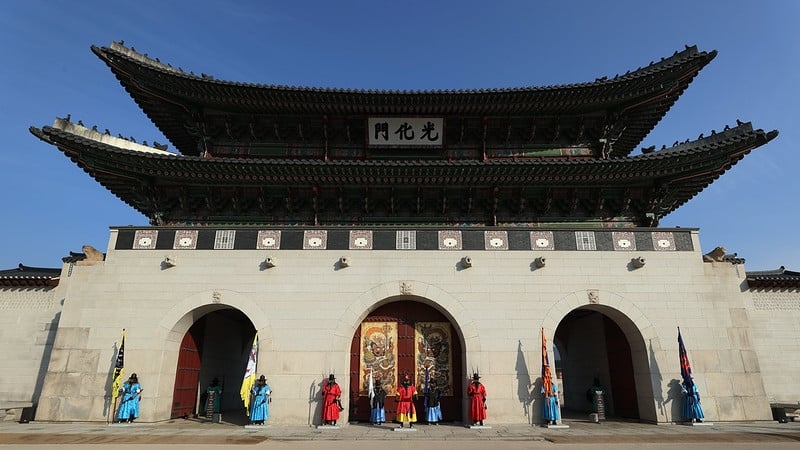
Image credit: Republic of Korea
One of the most popular times to visit Gyeongbokgung Palace is for the Changing of the Guard ceremony, conducted by the Sumunjang (the Royal Guard). The full ceremony occurs twice a day at 10am and 2pm; there are also two shorter ceremonies at 11am and 1pm. We suggest visiting Gwanghwamun Gate, which is the largest gate in the Royal Palace. Do head over earlier and be prepared for crowds!
Fun fact: There is also an earlier “secret” military training exercise for the Sumungun (gateway soldiers), at 9.35am.
2. Changdeokgung Palace (Palace of Prospering Virtue)
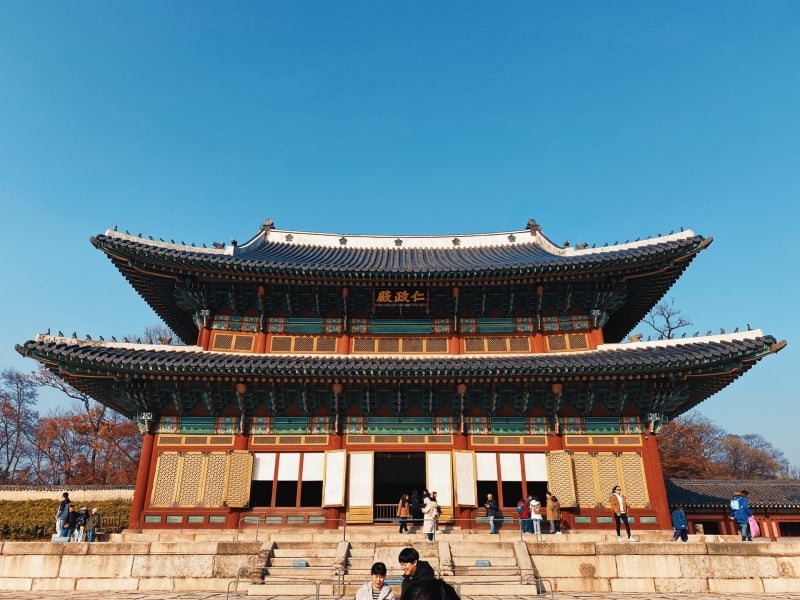
Image credit: xandreaswork
Changdeokgung Palace (aka Eastern Palace) is a UNESCO World Heritage Site and functions as the primary palace for many kings of the Joseon dynasty. Up till now, it is the best-preserved of the five remaining royal palaces in South Korea.
It is located at the foot of Ungbong Peak of Mount Baegaksan. The palace designed with the topography in mind according to pungsu (divine principles based on geographic features). Hence, the palace itself is built towards the south, while its Biwon (meaning “secret garden”) faces the north. The complex’s buildings were arranged both functionally and symbolically according to Confucian ideals.
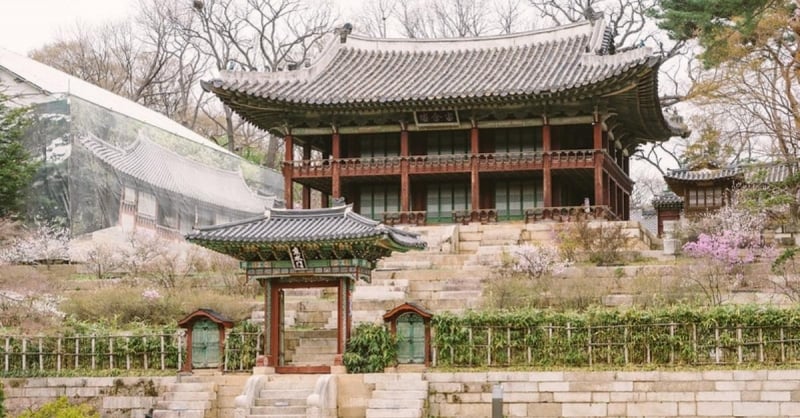
Image credit: Wei-Te Wong
The Biwon was not only a place of respite for the royal family but also a site for government exams. It features a series of trees, flowers, a lotus pool, and numerous pavilions set against a wooded background.
It is best to visit Changdeokgung Palace in spring to witness the lovely cherry blossoms. Otherwise, autumn also offers shades of vibrant foliage.
Fun fact: There are at least 56,000 varieties of plants in the garden, including walnut, white oak, zelkova, plum, maple, chestnut, hornbeam, yew, gingko, and pine trees!
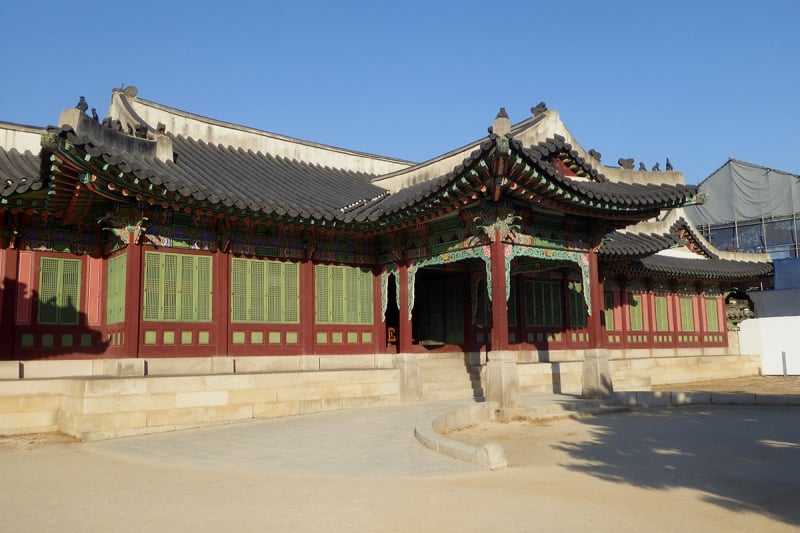
Image credit: Ethan Doyle White
It stands out due to its artistic interior having many tiled roofs, with a multi-bracket system and decorative carvings. The attractive colours will leave you gaping at how truly remarkable Korean architecture can be.
Conversation efforts from the Cultural Heritage Protection Act will continue to preserve this palace for many years to come due to its paramount importance.
3. Changgyeonggung Palace
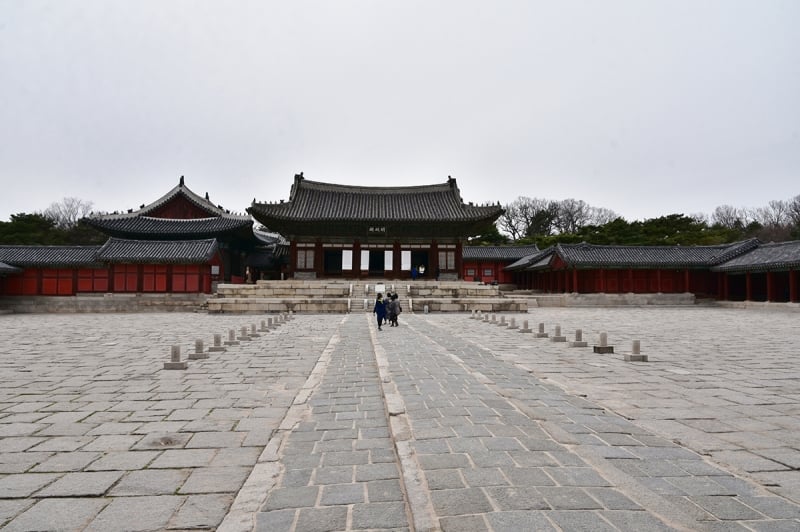
Image credit: Richard Mortel
Originally built by King Sejong for his retiring father, King Taejong, Changgyeonggung Palace was formerly known as Suganggung Palace. It was connected to Changdeokgung Palace. Compared to the other Royal Palaces, this is rather small and compact.
This palace often served as residential quarters for queens and concubines. During the Japanese occupation, it had a zoo, botanical garden, and museum. It also appeared in the historical K-drama film, The Throne, which depicts a scene of the sealing of Crown Prince Sado in a wooden rice chest.
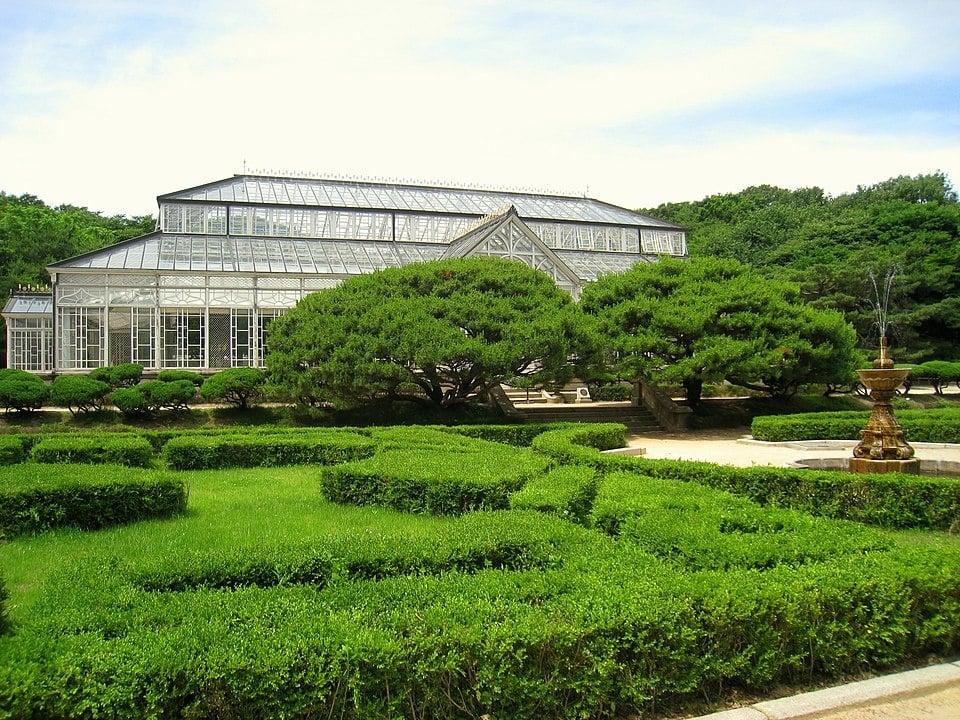
Image credit: Daderot
Not known to many, Changgyeonggung Palace also has the Daeonsil (Grand Greenhouse). The Japanese built this Victorian-style greenhouse in 1909, alongside the zoo. The ridge of the roof features repeated plum designs, typical of royal motifs. In front of the greenhouse, there is a Renaissance fountain and a maze-like garden.
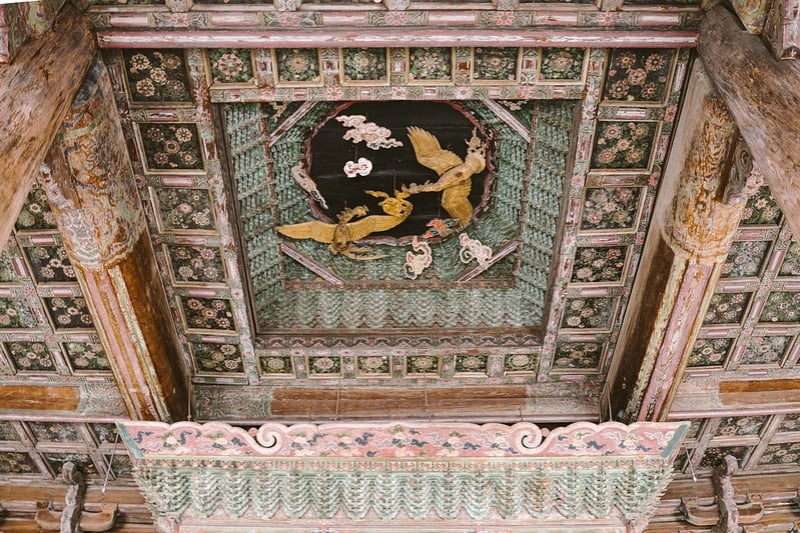
Image credit: Wei-Te Wong
Changgyeonggung Palace has undergone several destructions due to war and has been restored to resemble its original form. Myeongjeongjeon is the jeongjeon (main hall) of the palace, where state affairs were held. It is also the oldest main hall of all of the royal Joseon palaces.
Unlike the south-facing main halls of other palaces, Myeongjeongjeon faces east. Its inner interior boasts floral motifs and a golden pair of phoenixes flying between five clouds with a cintamani (wish-fulfilling gem).
Fun fact: One of the halls, Tongmyeongjeon, was the location of a royal scandal. Janghuibin, King Sukjong’s favourite concubine, was discovered to have buried puppets and dead animals in front of the hall to curse Queen Inhyeon.
4. Deoksugung Palace (Palace of Virtuous Longevity)
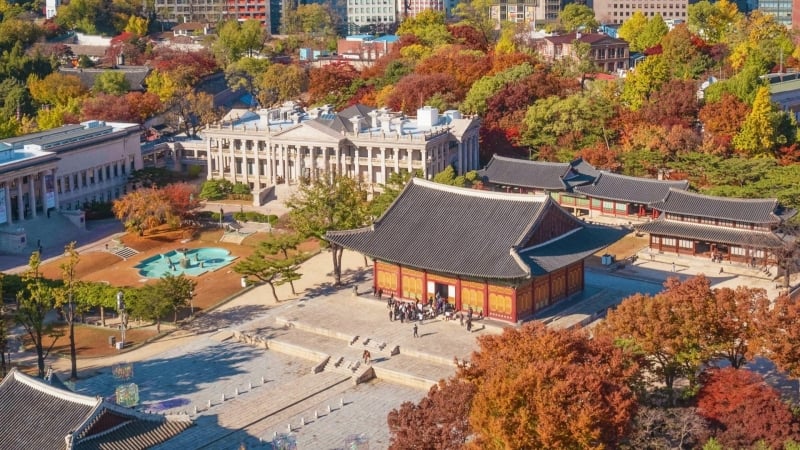
Image credit: SeongPhil Jang
A refreshing and eclectic palace, Deoksugung Palace is located at the corner of Seoul’s busiest downtown intersection. It was not classified as a royal palace at first. It was initially a residential home of Grand Prince Wolsan, the older brother of King Seongjong.
However, the royal family’s home burned down during the Imjin War. Hence, they had to relocate to this area. Subsequently, the palace alternated between being an official palace and a temporary residence. Among the palaces in South Korea, it is the only one with a one-story front gate.
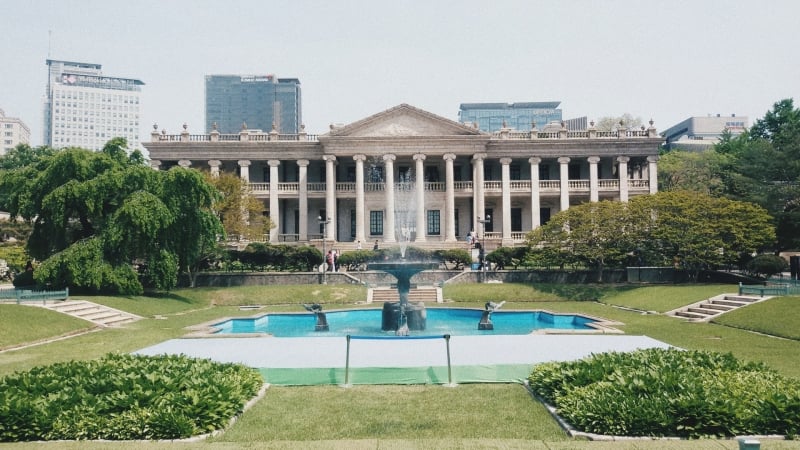
Image credit: chɑɒµͻ
Today, Deoksugung Palace is considered a Royal Palace of Seoul. It is famous for its elegant stone-wall road and integration of European architecture within the complex, such as the Greek-inspired temple and central fountain.
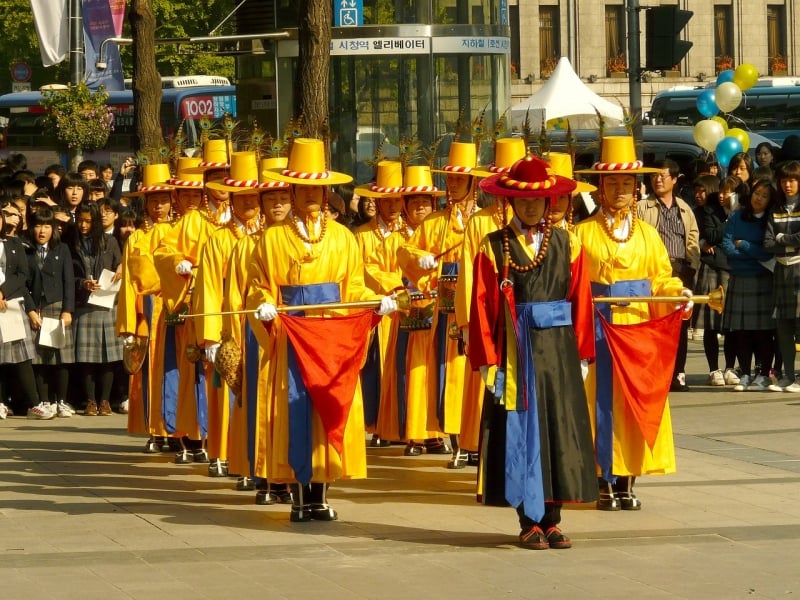
Image credit: sharonang
Similar to Gyeongbokgung Palace, the Changing of the Royal Guard also occurs in front of Daehanmun Gate twice a day, at 11am and 2pm. The zenith of the ceremony occurs when 18 guards in six official positions beat a drum and command some orders. Note that there are no ceremonies on Mondays, as well as on severely cold or hot days. You can even take pictures with the gatekeepers once the ceremony is over!
5. Gyeonghuigung Palace (Palace of Serene Harmony)
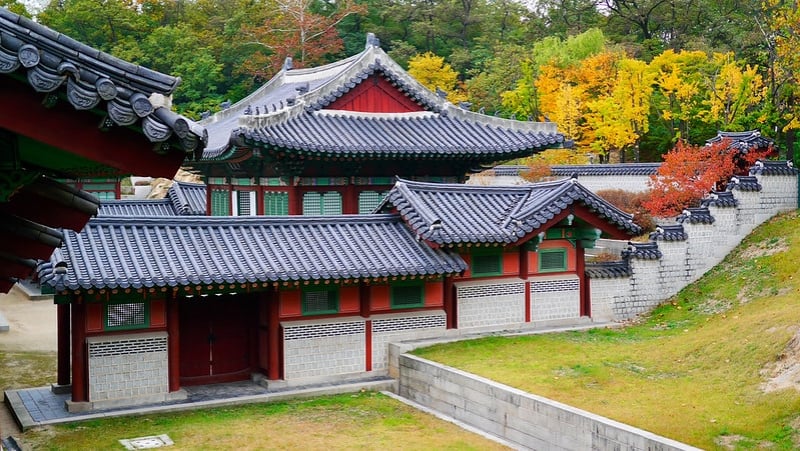
Image credit: travel oriented
Gyeonghuigung Palace (aka Western Palace) was known as the emergency palace for the king. It is also the youngest among the palaces in South Korea. It once had more than 100 buildings, but some were destroyed during the Japanese occupation.
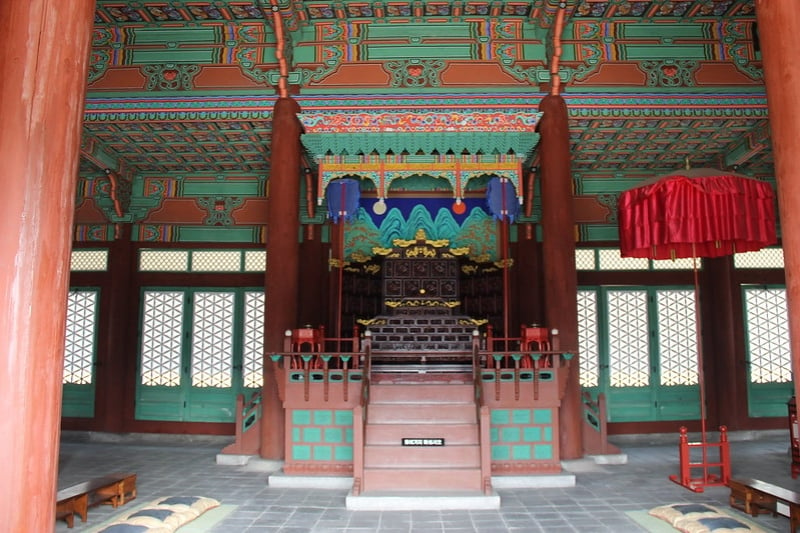
Image credit: Gary Todd
The Royal Palace now has the restoration of Heunghwamun Gate, the main gate of the palace, and Sungjeongjeon Hall, the main hall.
Despite it being lesser known than the other palaces, this Royal Palace is still ideal to visit. You can appreciate authentic Korean architecture minus the large crowds.
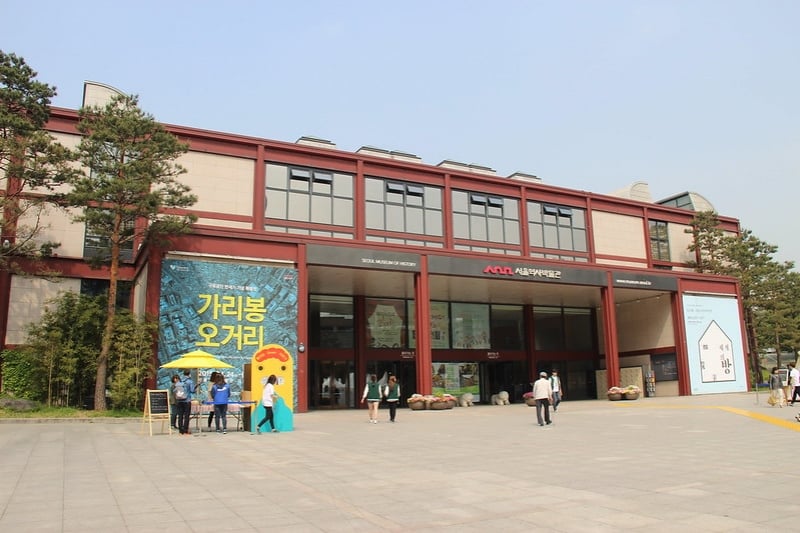
Image credit: Gary Todd
On the palace grounds, you can find the Seoul Museum of History (pictured above) and the Gyeonghuigung Annex Building of the Seoul Museum of Art.
The former offers visitors a glimpse into the history and development of Korea from prehistoric times to the present day. Meanwhile, the latter is located in the 600-year-old Memorial Hall and holds an extensive collection of exhibitions from art organisations.
Admission: Free
6. Jongmyo Royal Shrine
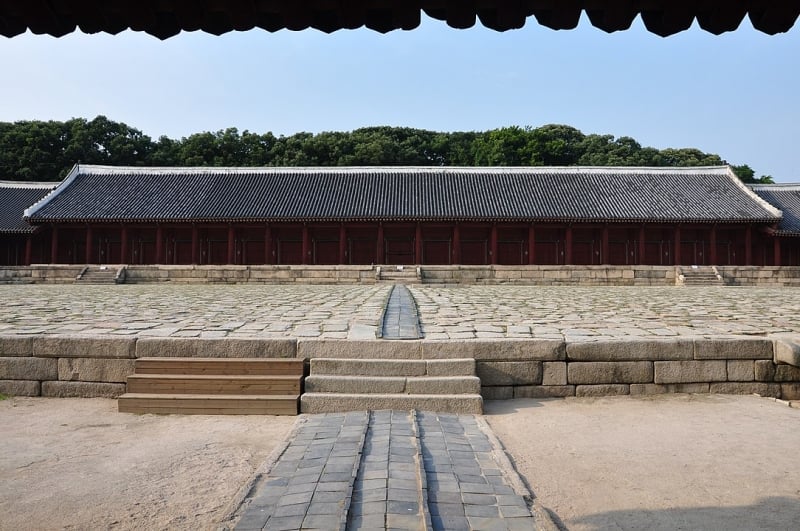
Image credit: Oskar Alexanderson
Adjacent to Changdeokgung Palace and Changgyeong Palace in the south, the Jongmyo Royal Shrine is a Confucian shrine dedicated to the kings and queens of the Joseon dynasty. It is classified as a UNESCO World Heritage Site because it is the oldest royal Confucian shrine in the country.
The shrine stands as a symbol of the legitimacy of the royal family and houses the spirit tablets of former rules of the Joseon Dynasty. There are two royal memorial halls. Jeongjeon, the main hall, contains 19 spirit chambers housing 49 spirit tablets. Yeongnyeongjeon (Hall of Eternal Peace), on the other hand, contains 16 spirit chambers housing 34 spirit tablets.
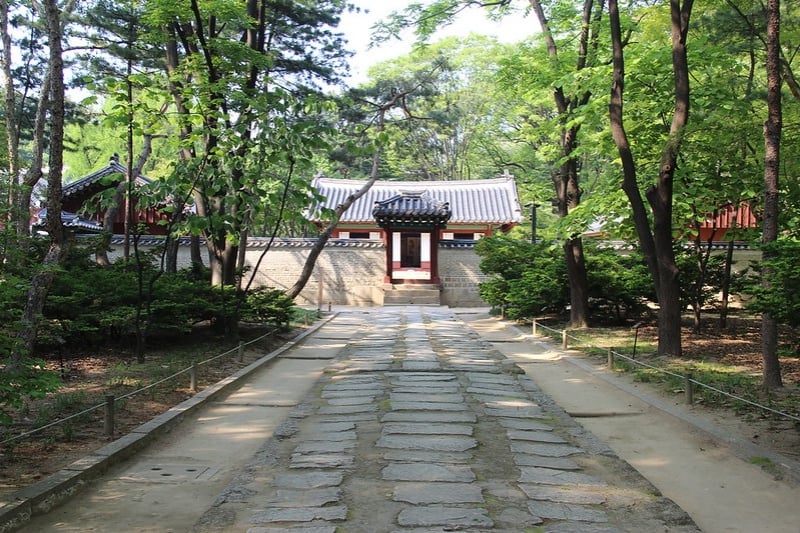
Image credit: Gary Todd
Jongmyo Jerye is a 600-year-old royal Confucian ancestral ritual that has also been listed as a World Intangible Cultural Heritage. It is still carried out today.
Also read: 10 Most Famous UNESCO World Heritage Sites You Need to Visit in South Korea
Royal historical gates and fortresses in South Korea
7. Namdaemun Gate
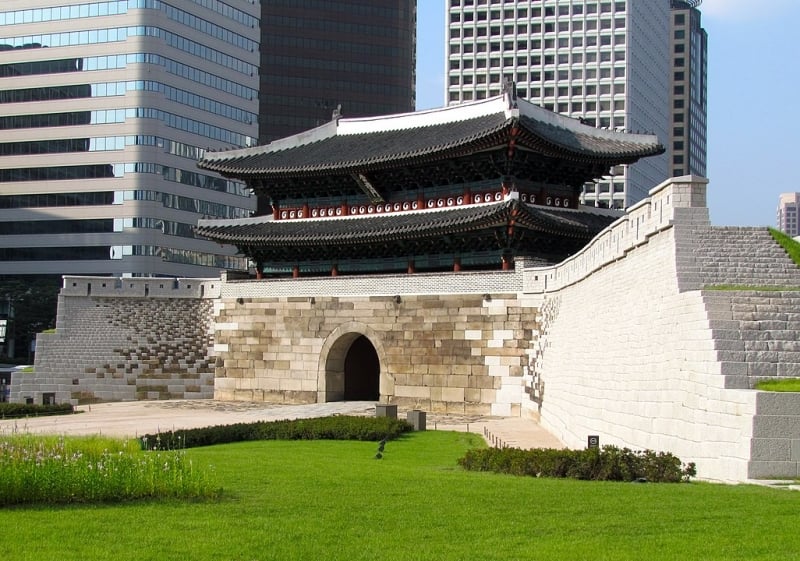
Image credit: DoulosCore
Namdaemun is the most famous of the Eight Gates in the Fortress Wall of Seoul. It has a historic pagoda-style gateway, and is designated as the first National Treasure of South Korea!
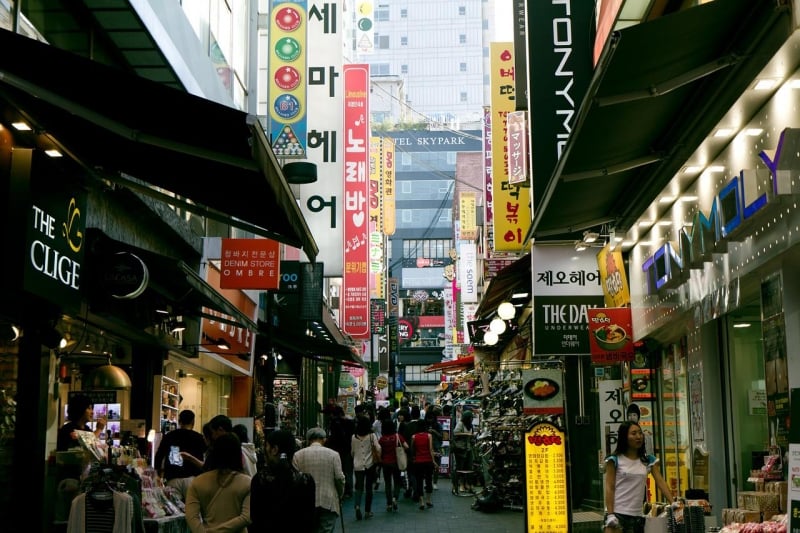
Image credit: tragrpx
Beside the gate is also the 24-hour Namdaemun Market, which is the largest and oldest traditional market in Korea. It’s a famous tourist attraction where people buy clothing at wholesale prices. You can also savour some street food here, including hotteok: a traditional sweet Korean pancake filled with nuts and honey.
Admission: Free
8. Namhansanseong Fortress & Emergency Palace
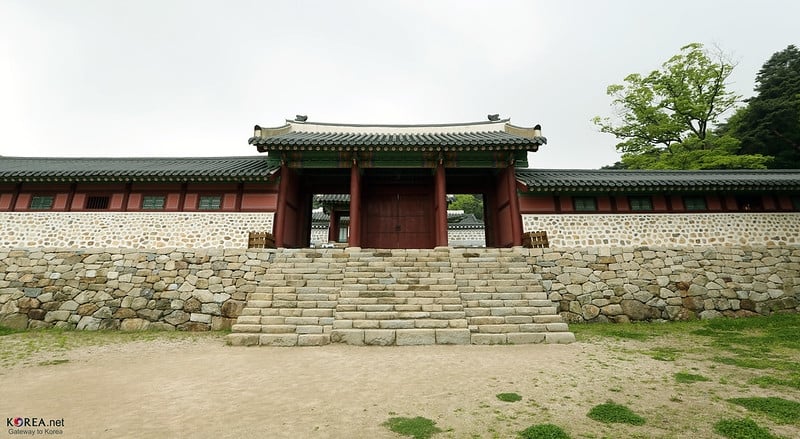
Image credit: Republic of Korea
Namhansanseong Fortress is a UNESCO World Heritage Site that was once the emergency capital of the Joseon dynasty. It is a South Korean fortress that you have to visit in order to truly comprehend the history of the country.
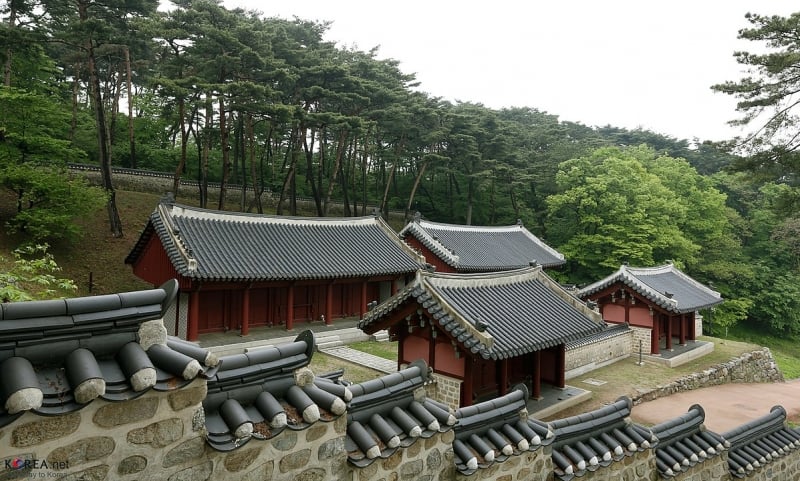
Image credit: Republic of Korea
Namhansanseong Emergency Palace is a haenggung (palace of temporary stay) that is built at a strategic location outside the capital. It is the only haenggung to contain jwajeon (royal ancestral shrines) and usil, (altars for deities of earth and grain).
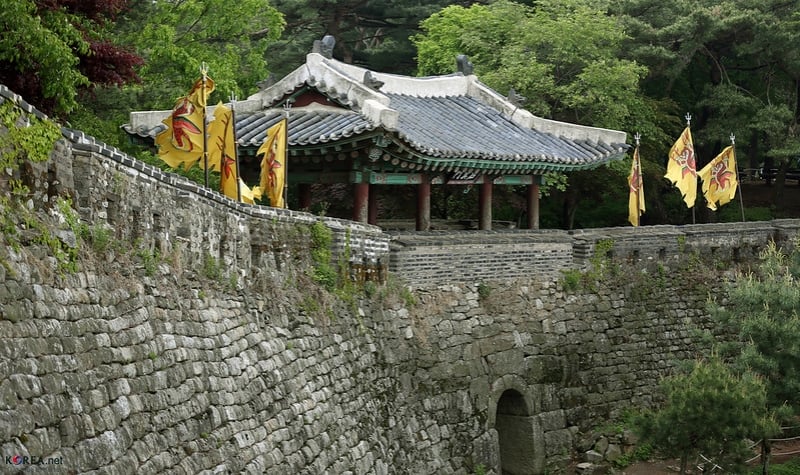
Image Credit: Republic of Korea
Its architecture stems from a re-examination of Chinese and Korean standards of urban fortification, especially when enemies from the West began to use new firearms.
Admission: Namhansanseong Emergency Palace only: Adult (19-64): ₩1,000 won, Child (age 7-18): ₩500, Senior (above 64): Free
9. Bukhansanseong Fortress (Fortress of the mountains north of the Han)
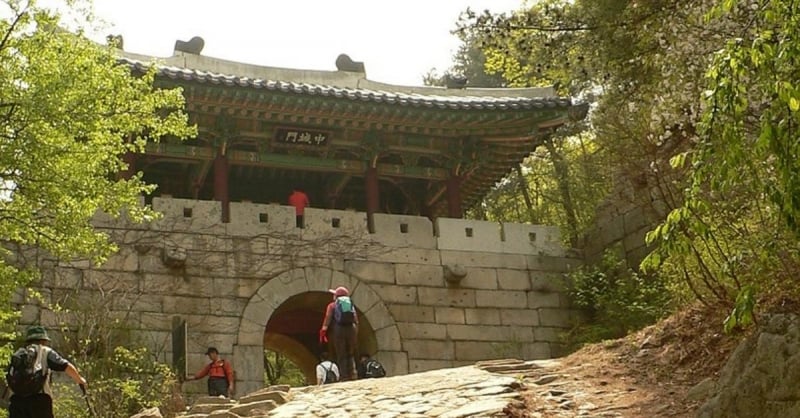
Image credit: Nagyman
Bukhansanseong Fortress offers hiking trails all the way to the top where you will get rewarded with a breathtaking view of the area of Bukhansan National Park. Bukhansanseong Fortress was built along the mountain ridges of Mount Bukhan to prevent foreign invasion.
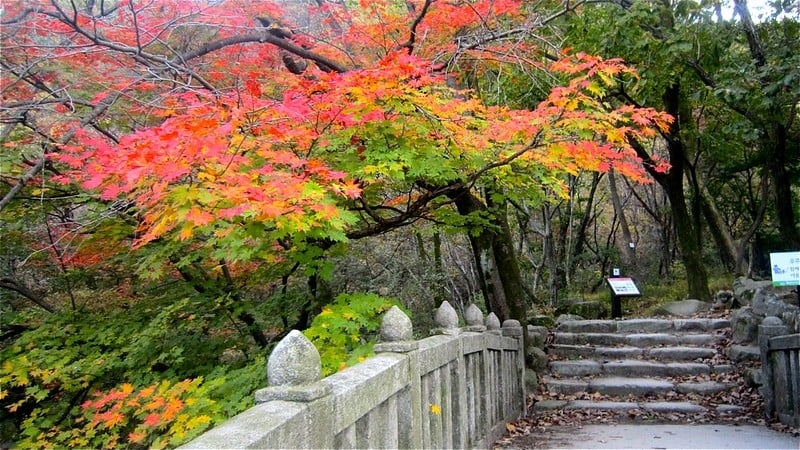
Image Credit: anokarina
Bukhansan National Park has dozens of gorges and granite peaks with crystal clear streams flowing between them. It also is home to about 3,100 species of plants and animals, beautiful numerous historic relics and Buddhist temples. It is especially great to visit in autumn when you can marvel at the foliage of orange leaves along the path.
Admission: Free
10. Suwon Hwaseong Fortress
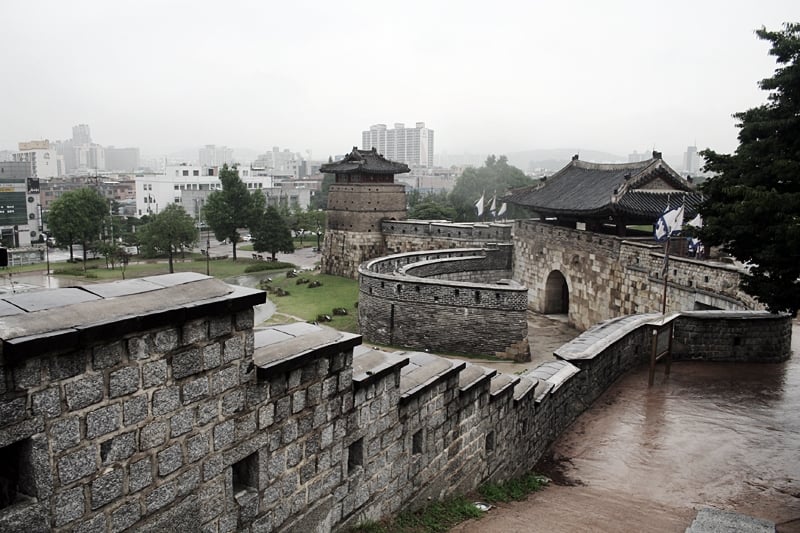
Image credit: d’n’c
The Suwon Hwaseong Fortress was built in the late 18th century by King Jeongjo to form a new political basis and honour the remains of his father.
It is definitely a must-see in South Korea, having the designation of a UNESCO World Heritage Site. It is unique because of how it combined military, political, and commercial functions. The Suwoncheon river also flows through the centre of this fortress.
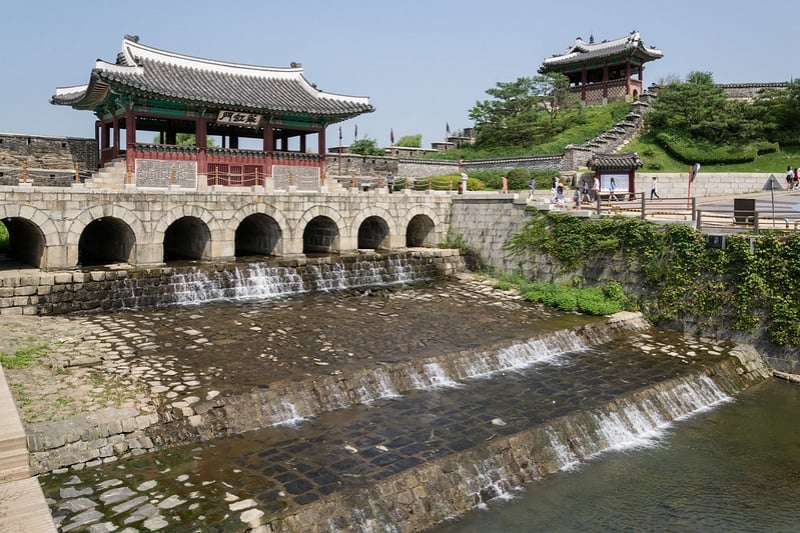
Image credit: Domenico Convertini
The walls incorporate a number of defensive features. They comprise floodgates, observation towers, command posts, multiple arrow launcher towers, secret gates, bunkers, and more.
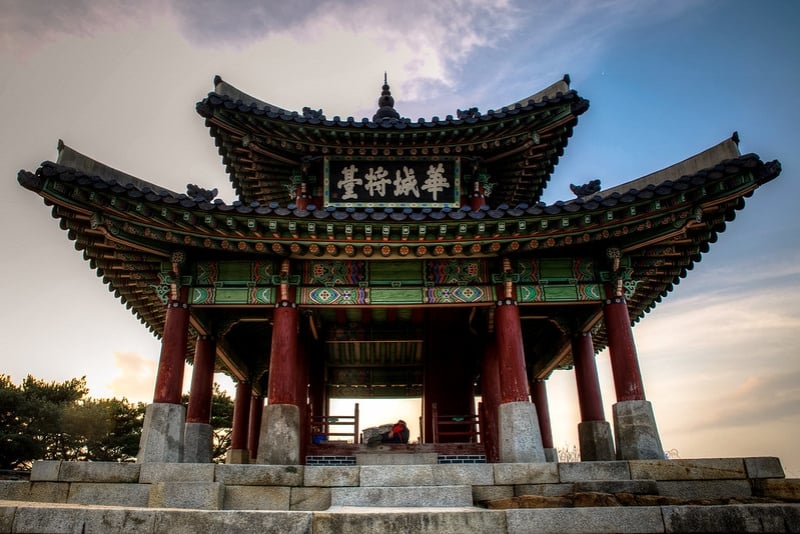
Image credit: Carmine.shot
The highest point in Hwaseong Fortress at the top of Mount Paldal, Seojangdae (Western Command Post) provides a bird’s eye view.
Also read: 9 Useful South Korea Tips If You’re a First-Time Traveller
We all know that K-pop and K-drama have been on the rise around the world. Now, consider taking your fascination with Korean culture up a notch by checking out its historical places, too. What are you waiting for? On your next trip, take the time to admire the fortresses and royal palaces in South Korea!




